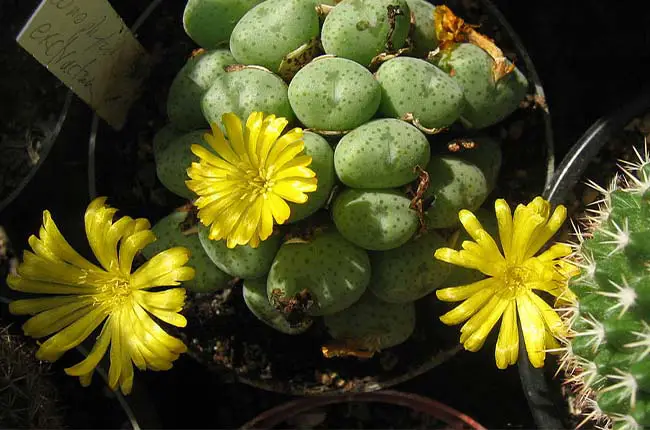Succulents that flower are special, and those that exhale fragrance are even more so.
Scented succulents include many Mesemb species, night-blooming cacti, and Aloes from Madagascar. Their flowers can range from tiny blooms with neon colors to large, showy flowers, and the fragrance is unusual, ranging from overwhelmingly spicy, to sweet perfumes resembling coconut, honey, grapefruit, and lime.
If you are looking to expand your succulent collection with some olfactory stimulation, read on!
What type of succulents are scented?
Curiously, most of the succulents and cacti with scented blooms either have strong colors or bloom at night.
Many of them with a strong scent bloom at night and only even one night a year, while those that bloom in the daytime do not have a strong fragrance.
They also need to be mature plants, at least 5 years old, to start producing flowers. They may produce only a few blooms during their first year of blooming but will produce many more in subsequent years.
For succulents, those with fragrant blooms are from the Mesembryanthemoideae genus (also known as Mesemb) in the family of Aizoaceae (“ice plants”).
For cacti, many of those with fragrant blooms are night-flowering.
And for aloes, many of the scented ones are from Madagascar.
The following is a list of 14 types of succulents, cacti, and aloes with scented blooms.
1. Conophytums
Conophytums are from the Mesemb genus (in the family of Aizoaceae) with fragrant flowers.
They are round, stemless bodies that are shaped like rocks. Their flowers have showy neon colors and are shaped like a bottle brush.
For example:
- Conophytum minimum ‘Wittebergense’ has tiny white flowers. It is a network of small rounded bodies covered in highly decorative dark variegated patterns.
- Conophytum spectabile
- Conophytum novicium
- Conophytum extraktum
- Conophytum meyeri is a dwarf two-lobed leaf succulent with highly scented bright yellow flowers.

2. Neohenricia
The Neohenricia species are tiny succulents from the Mesemb genus (in the family of Aizoaceae). Although they have tiny leaves and tiny flowers that only bloom on summer nights, they exhale a powerful musky scent of pineapple and coconut.
Its flowers appear as whitish, greenish at first, and then change to purple on subsequent days.
Example:
- Neohenricia sibbettii (“coral plant”)
3. Stomatiums
Stomatium is a genus in the Aizoaceae family with scented flowers.
They are small succulents that expand sideways forming ground-covering mats. Their flowers are white or pink and bloom at night with a coconut-like scent. For example:
- Stomatium suaveolens
- Stomatium alboroseum
4. Pleiospilos
Pleiospilos (also known as “Split Rock Plant”) is a flowering genus of the Aizoaceae famiiy.
They are stemless succulents that are only a few inches tall. They produce orange or yellow daisy-like flowers that smell like coconut. For example:
- Pleiospilos nobilis
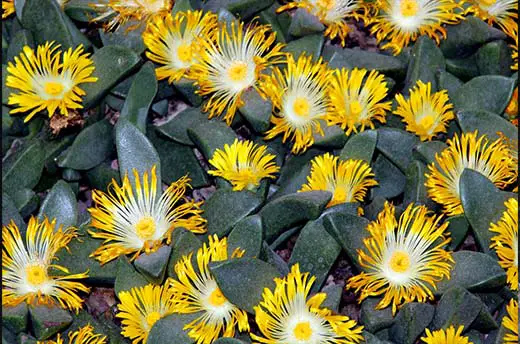
5. Sansevieria (Mother-in-Law’s Tongue)
It is quite rare for Sansevieria (commonly known as “mother in law’s tongue” or “snake plant”) (from the Asparagaceae family) to flower as it needs to be a mature plant to produce blooms. When it does, it blooms once a year in spring.
Its flower stalk can reach up to 3 feet (1 meter) long, covered in tiny flowers.
The flowers look like cream-colored lilies and have a strong, pleasant musky scent.
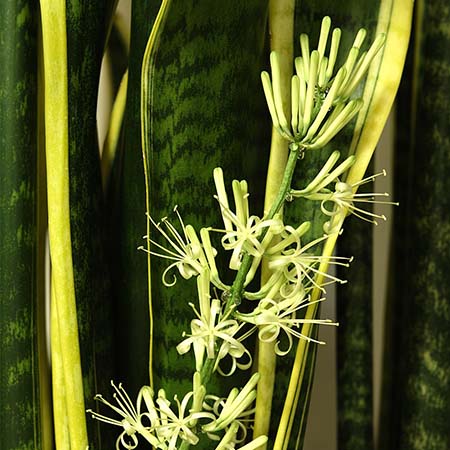
6. Euphorbia
Some species from the Euphorbia genus have flowers with a pleasant lime-like perfume. For example:
- Euphorbia melaformis
- Euphorbia valida
- Euphorbia obesa
But be careful that if you break some of their plant tissues, they release a milky sap that is toxic and highly irritating to the skin and eyes.
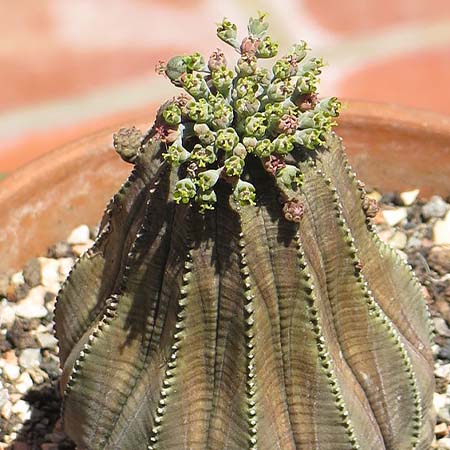
7. Lithops
Many Lithops (from the Aizoaceae family) have scented flowers. However, it is a faint scent of honey, not something that can fill the room.
For example:
- Lericheana has white flowers that are sweet-scented.
- Lithop pseudotruncatella ssp
8. Crassula
Many Crassulas have fragrant, star-shaped flowers in clusters. For example:
- Crassula Springtime has pale pink, star-shaped, scented blooms.
- Crassula fascicularis
- Crassula Falcate
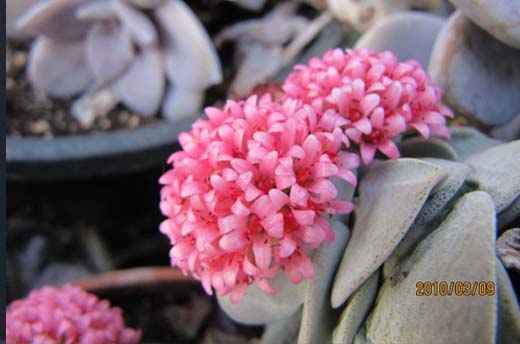
9. Night-Blooming Cereus
Night-blooming Cereus (also known as epiphytic cacti, or “orchid cactus”) are species of the Epiphyllum family native to Central and South America. Not all Epiphyllum species produce fragrant blooms. For example, schlumbergera bridgesii (“Christmas cactus”) do not have scented blooms.
Their flowers have a very strong and spicy fragrance and some may find it too overwhelming for the indoor. The white Epiphyllum of the Cooperii has a heavy lily-like fragrance.
The night-blooming cereus generally takes around 5 years to mature before they produce flowers.
They all bear white flowers with a touch of yellow, except Epiphyllum ackermannii which has bright red flowers. They all have large cupped flowers with feathery petals and a diameter of 3-6 inches (8-16 cm) that open only for a single night.
For example:
- Peniocereus greggii (“Arizona queen of the night”)
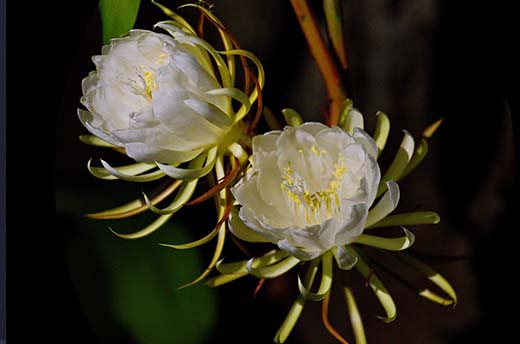
Here is a time-lapse of a night-blooming cereus:
10. Eriosyce
All the Eriosyce species (from the cactus family) have large, scented blooms that appear at the apex, from young areoles of the cactus.
They are native to Chile and bloom in the morning and close at night. Their scent is mellow but their blooms are large and showy. For example:
- Eriosyce tenebrica
- Eriosyce heinrichiana
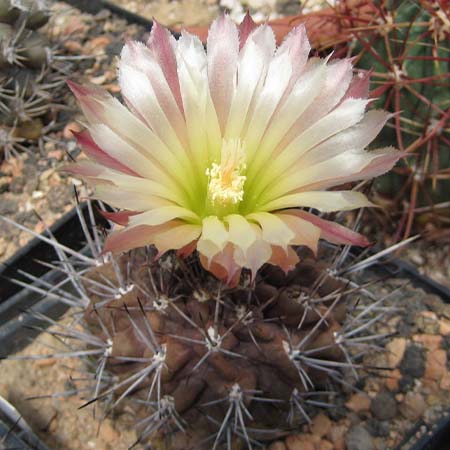
11. Echinopsis
Several Echinopsis species from the cactus family are night-flowering with strong notable fragrance that can fill the whole room.
They are native to South America and are also known as “hedgehog cacti” or “sea urchin cactus” because of the dense covering of spines. For example:
- Eriosyce paucicostata
- Echinocereus pectinatus
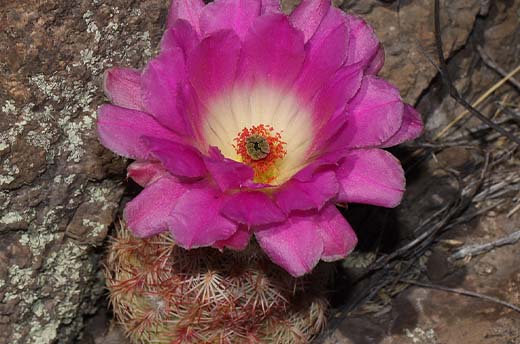
12. Astrophytum myriostigma
Astrophytum myriostigma v. qudricostata, also known as the “bishop’s hat cactus”, produces a series of deep yellow flowers during the summer and has a faint trailing fragrance.
13. Mammillaria
Some Mammillaria species from the cactus or Cactaceae family have fragrant flowers. For example:
- Mammillaria blossfeldiana
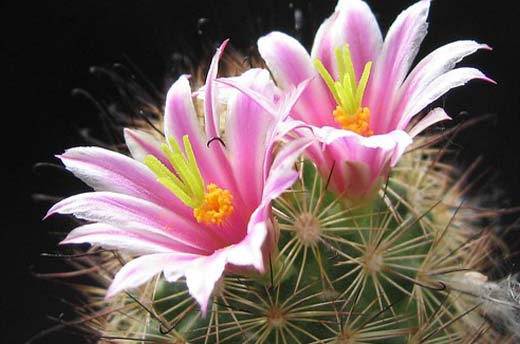
- Mammillaria camptotricha is the easiest to flower. It has creamy colored flowers and the scent of lime trees. The plant is also called “Bird’s Nest Cactus” because it has long curved spines and clusters freely.
- Mammillaria (Dolichothele) longimamma has large yellow and fragrant flowers.
14. Aloes from Madagascar
Of a total of approximately 350 Aloe species, only seven produce flowers with fragrance, and the smell resembles sweet grapefruit.
These scented aloes are all native to Madagascar, except one (last one on the following list):
- Aloe betsileensis
- Aloe compressa
- Aloe conifera
- Aloe cryptoflora
- Aloe haworthioides
- Aloe suzannae
- Aloe modesta is native to South Africa
Why are some succulents fragrant?
Notice that most succulents with a strong scent either have sharp neon-like flower colors or bloom at night?
Their strong fragrance serves to attract pollinators, mostly insects, to tiny insignificant succulents and night-blooming cereus that only blooms for a few hours at night once a year.
This allows nocturnal insects such as moths, and also daytime pollinators such as butterflies and bees to detect both the colors and scents produced by the flowers.
The pollinators are first attracted to the flowers from afar by the strong colors and the strong fragrance helps them to accurately identify the flowers at a close distance.
And your pick?
So, these are the 14 types of scented succulents, each with many species sharing similar characteristics.
If you are looking to expand your indoor succulent collection, the best would be tiny Mesembs (such as Conophytums, Pleiospilos) and blooming cactus (such as Mammillaria and Eriosyce) with blooms with
strong neon colors and mellow, sweet candy perfumes.
For your outdoor garden, the best would be Crassula and night-blooming cereus which has showy flowers and an overwhelmingly spicy scent.
What’s your pick? Share your thoughts in our community of garden lovers.
Happy gardening!
Related
17 Amazing Full-Sun Orchids (How To Acclimatize Them)
Top 41 Acid-Loving Plants (A to Z list)
22 Plants For Your Bee-Free Garden
Sources
Van der Riet, W. B. (1977). Aloe Modesta – Our Fragrant Aloe. Veld and Flora.
Photo credits
Petar43, CC BY-SA 4.0, via Wikimedia Commons
“Pleiospilos nobilis” by M. Martin Vicente is licensed under CC0 1.0
Dornenwolf from Deutschland, CC BY 2.0, via Wikimedia Commons
“CACTUS, RAINBOW (Echinocereus pectinatus) (6-2-11) bog hole, scc,az -02” by Sloalan is licensed under CC0 1.0
“Epiphyllum are blossoming” by tuanleanh5561 is licensed under CC PDM 1.0
Petar43, CC BY-SA 4.0, via Wikimedia Commons
Mlogic, CC BY-SA 3.0, via Wikimedia Commons
Petar43, CC BY-SA 3.0, via Wikimedia Commons
“Crassula (falcata?)” by wallygrom is licensed under CC BY-SA 2.0
Jurema Oliveira, “File:Eriosyce heinrichiana subsp intermedia.jpg” by Michael Wolf is licensed under CC BY-SA 2.0
- Keiki Paste vs Rooting Hormone:What’s the difference? - February 4, 2024
- Top 10 Orchid Fertilizers: A Comprehensive Review (2024) - February 2, 2024
- Top 8 Soil Inoculants For Stronger Plants (2024) - February 1, 2024

